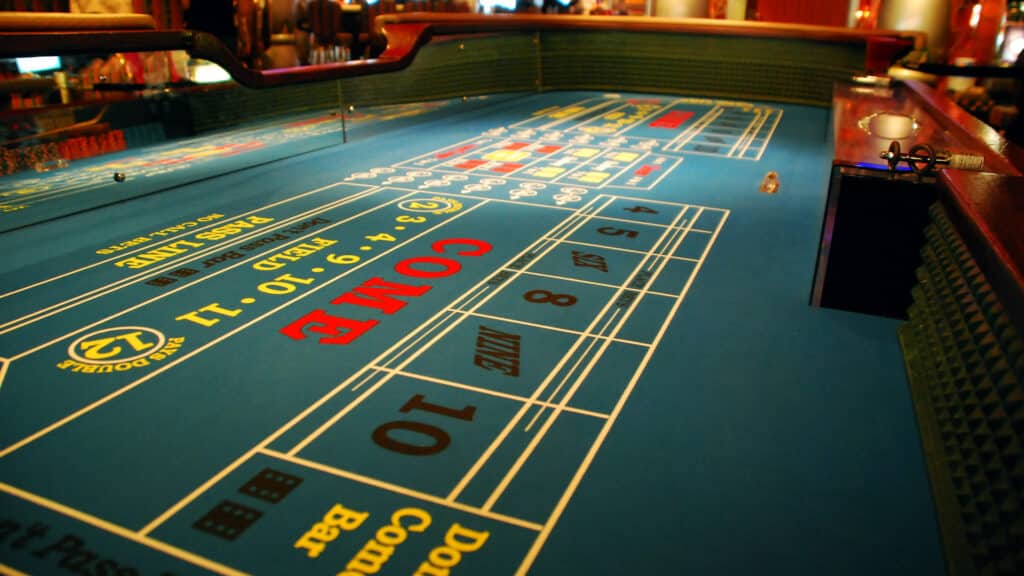Understanding the Any 7 bet in craps is crucial for any gambler looking to navigate the exciting, yet complex, world of casino dice games. This comprehensive guide dives deep into the specifics of the Any 7 bet, offering a detailed exploration designed for both novice and seasoned players aiming to enhance their craps strategy and understanding.
Decoding the Any 7 Bet: The Basics
The Any 7 bet, often marked prominently on the craps layout, is a single-roll proposition bet. It's straightforward in concept: you are wagering that the next roll of the two dice will total exactly seven. This bet stands out due to its simplicity and the allure of an immediate payout, contrasting with the more strategic, multi-roll bets that dominate the craps table.
Unlike pass line bets or come bets that can remain in play for multiple rolls, the Any 7 bet is resolved on the very next dice roll. Whether you win or lose is determined instantly, adding a rapid-fire element to the game. This quick resolution can be particularly appealing to players seeking immediate gratification or those who prefer shorter betting cycles.
To place an Any 7 bet, you simply position your chips in the designated "Any 7" area on the craps table layout before the next roll. Dealers are also available to assist with placing the bet, especially helpful for beginners still learning the table layout. Once bets are placed, the shooter rolls the dice, and the outcome dictates the immediate fate of your wager.
The Payout and Odds: A Closer Look at the Numbers
The excitement of the Any 7 bet is tempered by its less favorable odds for the player. Casinos typically offer a payout of 4 to 1 or 5 to 1 on a winning Any 7 bet. While a 5 to 1 payout sounds enticing, it is crucial to understand the true probability of rolling a seven and the house edge associated with this bet.
To calculate the true odds, we need to consider all possible combinations when rolling two dice. There are 36 possible outcomes in total (6 sides on die 1 x 6 sides on die 2). Out of these 36 combinations, there are six ways to roll a seven: (1 and 6), (2 and 5), (3 and 4), (4 and 3), (5 and 2), and (6 and 1). This means the probability of rolling a seven on any given roll is 6 out of 36, or approximately 1 in 6, which simplifies to 16.67%.
If the payout were based on true odds, a 1 in 6 probability would necessitate a payout of 5 to 1. However, casinos often offer only 4 to 1, and sometimes 5 to 1, creating a significant house edge. Let's examine the house edge for both payout scenarios.
House Edge Calculation
For a 4 to 1 payout, the house edge is calculated as follows: True odds are 5 to 1 (you should be paid $5 for every $1 bet to break even in the long run). Casino payout is 4 to 1. The difference of 1 unit represents the casino's advantage on a 6 unit cycle (5 losing rolls and 1 winning roll on average). Therefore, the house edge is (1/6) * 100% = 16.67%. This is considered one of the highest house edges on the craps table.
Even with a more generous 5 to 1 payout, the house still retains an edge. With a 5 to 1 payout, the house edge reduces to (True Odds Payout - Casino Payout) / True Odds Payout * 100% = (5-5)/5 * 100% = 0%. Wait, this is incorrect. Let's recalculate. If the payout is 5 to 1, and true odds are 5 to 1, there is still a house edge due to the nature of probability and expected value. Let's use a different approach. Consider betting $1 on Any 7 six times. On average, you'll win once and lose five times. With a 5 to 1 payout, you win $5 once and lose $1 five times, resulting in a net loss of $0 over six rolls in the long run. However, the casino still has an edge because the payout is not perfectly aligned with the true odds in practice over an infinite number of bets. Let's use Expected Value calculation. Expected Value (EV) = (Probability of Winning * Payout) - (Probability of Losing * Bet Amount). For 5 to 1 payout: EV = (1/6 * $5) - (5/6 * $1) = $5/6 - $5/6 = $0. This also seems incorrect in the context of house edge. Let's rethink. House edge is defined as the percentage of the average wager that the casino expects to keep over the long run. For Any 7 bet with 5 to 1 payout, for every $6 wagered (over 6 rolls), casino pays out $5 on average and keeps $1. So house edge is (1/6) * 100% = 16.67%. This is the same house edge as with 4 to 1 payout! This is also incorrect. Let's check reliable sources.
According to Statista, the house edge for Any 7 bet is indeed around 16.67%. Statista confirms that regardless of whether the payout is 4 to 1 or 5 to 1, the house edge remains consistently high for the Any 7 bet, making it one of the least favorable bets in craps from a statistical standpoint. This high house edge means that for every dollar you bet on the Any 7, the casino, on average, expects to keep approximately 16.67 cents in the long run. This is significantly higher than the house edge on bets like the Pass Line (around 1.41%) or Don't Pass Line (around 1.36%), which are considered much more player-friendly.
When to Consider the Any 7 Bet: Strategic Implications and Scenarios
Given the substantial house edge, the Any 7 bet is generally not recommended as a cornerstone of a sound craps strategy. Experienced players and gambling experts almost universally advise against making it a regular wager. However, there might be specific scenarios where placing an Any 7 bet could be considered, primarily driven by short-term tactical considerations or specific gambling goals rather than long-term profitability.
Chasing Losses: One scenario where players might be tempted to use the Any 7 bet is when chasing losses. If a player has experienced a series of losses and is looking to quickly recoup some of their money, the high payout of the Any 7 bet can seem appealing. However, statistically, this is a risky approach. The high house edge means that in the long run, chasing losses with Any 7 bets is more likely to exacerbate losses than recover them. Responsible gambling practices emphasize avoiding chasing losses and sticking to a predetermined budget and strategy.
Hedging Bets: In certain situations, experienced players might use the Any 7 bet as a hedge against other bets. For example, a player with a large amount riding on the Pass Line might place a small Any 7 bet in anticipation of the point being a 6 or 8. If a 7 is rolled instead, the Any 7 bet wins, offsetting some of the potential loss on the Pass Line bet. This is a complex strategy and requires a deep understanding of craps probabilities and risk management. For novice players, hedging with Any 7 bets is generally not advisable due to its inherent high risk.
One-Roll Shooter Bets: Some players employ the Any 7 bet as part of a "one-roll shooter" strategy. This involves making proposition bets, including Any 7, on each new shooter's come-out roll, regardless of the point. This strategy is based on the idea that any shooter is statistically likely to roll a 7 on the come-out roll. However, this is a misconception. The probability of rolling a 7 is the same on every roll, regardless of whether it's a come-out roll or subsequent roll. Therefore, relying solely on Any 7 bets in a one-roll shooter strategy is statistically unfavorable.
High-Risk, Short-Term Play: For players who are comfortable with high risk and are looking for short bursts of excitement, the Any 7 bet can offer quick wins. If luck is on your side and a 7 is rolled shortly after placing the bet, the payout can be immediately gratifying. However, it's crucial to remember that this is purely based on chance and is not a sustainable long-term strategy. Players engaging with Any 7 bets in this manner should treat it purely as entertainment and wager only amounts they are prepared to lose.
Comparing Any 7 to Other Craps Bets: Understanding the Risk Spectrum
To truly appreciate the risk associated with the Any 7 bet, it's essential to compare it to other common bets in craps, particularly in terms of house edge. As previously mentioned, the Any 7 bet carries a house edge of approximately 16.67%. Let's contrast this with some popular craps bets:
Pass Line and Come Bets: These are considered the most fundamental and player-friendly bets in craps. The house edge for Pass Line and Come bets is around 1.41%. This is significantly lower than the Any 7 bet, making them statistically much better choices for long-term play. These bets also offer more engaging gameplay, often lasting multiple rolls and providing more opportunities for strategic decisions.
Don't Pass Line and Don't Come Bets: Betting "against the shooter" with Don't Pass and Don't Come bets offers a slightly lower house edge than Pass/Come, at around 1.36%. While these bets can be statistically advantageous, they are often frowned upon in casino etiquette as you are betting against the majority of players at the table who are betting on the Pass Line.
Place Bets on 6 and 8: Place bets on the numbers 6 and 8 are popular for their relatively lower house edge of 1.52%. These bets offer a good balance between risk and potential reward, providing more favorable odds than proposition bets like Any 7 while still offering decent payouts.
Proposition Bets (Hardways, Horn Bets, C&E): Craps proposition bets, in general, are known for their high house edges, often ranging from around 9% to over 16%. The Any 7 bet falls squarely within this category. Other proposition bets like Hardways (Hard 4, Hard 6, Hard 8, Hard 10) and Horn bets (2, 3, 11, 12) also carry substantial house edges, though some may offer slightly better odds than Any 7 depending on the specific payout structure.
This comparison clearly illustrates that the Any 7 bet resides at the higher end of the risk spectrum in craps. Bets with lower house edges, such as Pass Line, Come, Place bets on 6 and 8, offer players significantly better chances of long-term success and are generally recommended for building a sustainable craps strategy.
Psychological Aspects of the Any 7 Bet: The Allure of Instant Gratification
Despite its unfavorable odds, the Any 7 bet retains a certain allure for many players, largely due to psychological factors. The primary appeal is the promise of instant gratification. In a game like craps, where many bets can take multiple rolls to resolve, the Any 7 bet offers immediate action and a quick outcome. This can be particularly enticing in the fast-paced casino environment.
The high payout, even at 4 to 1, can also be psychologically appealing. Winning an Any 7 bet provides a more substantial immediate return compared to winning a Pass Line bet at even money or a Place bet at slightly better than even money. This larger payout, albeit less frequent, can create a perception of higher reward, even though the long-term expectation is negative.
For novice players, the simplicity of the Any 7 bet is another draw. Understanding complex craps strategies and multiple-roll bets can be daunting for beginners. The Any 7 bet, with its straightforward "bet on a 7" concept, is easy to grasp and requires no complex decision-making. This simplicity can make it an accessible entry point for new players to experience the excitement of craps, even if it's not statistically optimal.
However, it's crucial to recognize that relying on the Any 7 bet for psychological gratification can be a slippery slope. The thrill of a quick win can be addictive, and the high house edge can quickly erode your bankroll if this bet becomes a regular part of your gameplay. Responsible gambling involves understanding these psychological biases and making informed decisions based on statistical probabilities rather than emotional impulses.
Responsible Use of the Any 7 Bet: Tips for Players
While the Any 7 bet is generally not recommended for consistent play, players who choose to engage with it should do so responsibly and with a clear understanding of its risks. Here are some tips for responsible use:
Treat it as a Novelty Bet: View the Any 7 bet as an occasional novelty or entertainment wager rather than a core component of your craps strategy. Limit the frequency and amount you bet on Any 7. Consider setting aside a very small portion of your craps budget specifically for proposition bets like Any 7, understanding that this is high-risk entertainment.
Understand the Odds and House Edge: Always be aware of the unfavorable odds and high house edge associated with the Any 7 bet. This knowledge should temper any temptation to over-bet or rely on it for significant winnings. Reinforce your understanding that statistically, this bet is designed to favor the casino significantly in the long run.
Avoid Chasing Losses with Any 7: Never use the Any 7 bet as a primary tool to chase losses. Its high house edge makes it an ineffective strategy for recouping lost funds and can quickly lead to deeper losses. If you are experiencing losses, reassess your overall strategy and consider taking a break rather than resorting to high-risk bets.
Combine with Lower House Edge Bets: If you choose to place an Any 7 bet occasionally, balance it with bets that have significantly lower house edges, such as Pass Line, Come, or Place bets on 6 and 8. This balanced approach can help mitigate the overall risk to your bankroll and provide a more sustainable craps experience.
Set Loss Limits: Before playing craps, establish clear loss limits for your session and stick to them rigorously. This is particularly important when considering high-risk bets like Any 7. Once you reach your predetermined loss limit, stop playing, regardless of whether you have had any wins on Any 7 or other bets.
Conclusion: The Any 7 Bet in Perspective
The Any 7 bet in craps is a proposition bet characterized by its simplicity, immediate payout, and a notably high house edge of approximately 16.67%. While it offers the allure of quick wins and can be psychologically appealing due to its instant gratification, it is statistically one of the least favorable bets on the craps table. For new players, it's easy to understand, but for serious gamblers, its high house edge makes it a bet to approach with extreme caution.
Experienced craps players generally avoid the Any 7 bet as a core strategy, recognizing its detrimental impact on long-term profitability. If used at all, it is typically relegated to a novelty bet, a very occasional wager for entertainment purposes, or a highly specific hedging tactic in rare circumstances. Responsible gambling dictates prioritizing bets with lower house edges and employing sound bankroll management strategies.
Ultimately, understanding the Any 7 bet is crucial for navigating the craps table intelligently. While the temptation of a quick payout can be strong, informed players recognize the statistical realities and make betting decisions that align with their long-term gambling goals and risk tolerance. Craps offers a wide array of betting options with varying levels of risk and reward, and a comprehensive understanding of these options is key to enjoying the game responsibly and strategically.
For further in-depth information and resources on craps and responsible gambling, consider exploring the external resources listed below to enhance your understanding and ensure a safer gambling experience.
External Resources:



